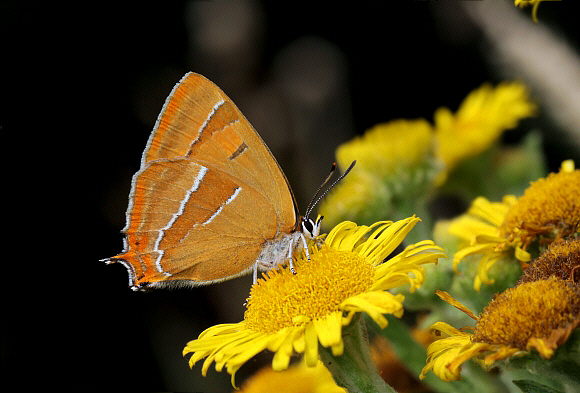 Brown Hairstreak Thecla betulae, female, Alner’s Gorse, Dorset – Adrian Hoskins
Brown Hairstreak Thecla betulae, female, Alner’s Gorse, Dorset – Adrian Hoskins
Introduction
The Brown Hairstreak is the last of the single-brooded butterflies to emerge in Britain, the males usually appearing around 4th August, and the females a week later. Females are distinguished by having a broad orange patch on the upperside forewings, and a more richly coloured golden-orange underside.
The butterfly gets its common name from the white hair-line streaks on the underside hindwings. Its scientific name betulae seems to be a complete misnomer – the word translates as “birch”, but it is not in any way associated with birch trees.
It is widely distributed across most of Europe, but absent from Portugal, southern Spain, Italy, the Mediterranean islands, Scotland and northern Scandinavia. Beyond Europe it occurs eastward across temperate Asia to Korea.
There are no other similar species in Europe, but novices often confuse this butterfly with the male Vapourer moth Orgyia antiqua which also flies around the tops of trees on sunny days. The Vapourer has a wild and erratic twisting flight over long distances, whereas the Brown Hairstreak tends to undertake very short flights, usually settling high in ash trees, but occasionally descending to visit flowers.
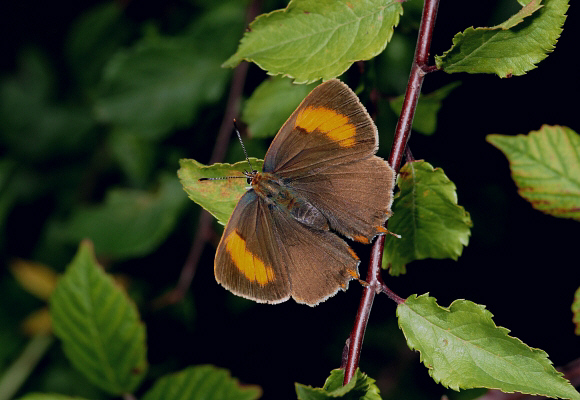 Thecla betulae, female basking between bouts of egg-laying, West Sussex – Adrian Hoskins
Thecla betulae, female basking between bouts of egg-laying, West Sussex – Adrian Hoskins
Habitats
In Britain this beautiful butterfly is considered a rarity, occurring in small discrete colonies scattered mainly across Hampshire, West Sussex, Dorset, Devon, Somerset, Oxfordshire and the western counties of Wales and Ireland. It is however a very elusive species, and certainly under-recorded, so it is likely that its distribution and abundance are both under-estimated.
This species breeds mainly along unmanaged blackthorn hedgerows, usually in association with ash trees which the adults use as assembly points when seeking mates. There are nevertheless several colonies where ash is not present, and at these sites the butterfly may use sycamores, oaks or other trees for assemblage. Colonies also exist in blackthorn thickets on sheltered scrubby downland; and along woodland edges and at the edges of rides in mixed or deciduous forests.
Most colonies are small and very localised, confined to a particular corner of a woodland or thicket, and comprising no more than a dozen or so adults at peak, and perhaps a total of about 60 adults over the entire flight season. Many colonies are smaller – e.g. there is a colony based on an isolated clump of blackthorn and ash at South Harting in Sussex, which probably comprises less than 6 adults at the peak of the flight period. At some sites the butterfly is much more widely dispersed, occuring at low densities over several hectares of unmanaged blackthorn / ash hedgerow. Sadly the current obsession with tidying up the countryside means that most hedgerows are trimmed mechanically, creating dense hedging that is unsuitable for the butterfly. Unfortunately misguided management also takes place at certain nature reserves, where obsessive scrub removal has drastically reduced suitable breeding habitat.
The butterfly can sometimes turn up in very odd situations, e.g. I once found an immaculate female in a dense beech plantation in West Sussex, half a kilometre from the nearest blackthorn bush, and 3 kilometres from the nearest known breeding site.
Females disperse over a wide area to lay their eggs, sometimes founding new colonies. Conversely, within their distribution range there are many apparently suitable sites from which the butterfly is entirely absent.
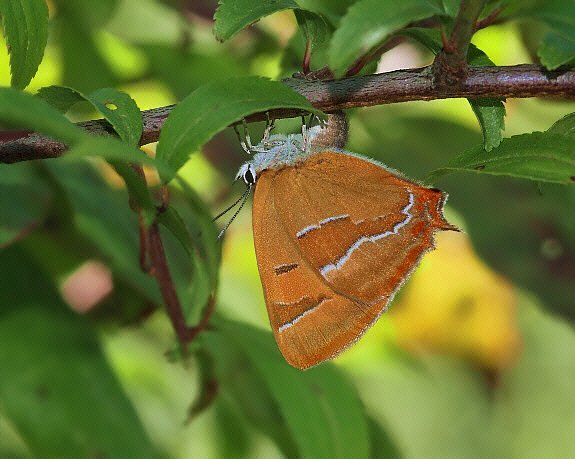 Brown Hairstreak Thecla betulae, female, ovipositing on blackthorn – Adrian Hoskins
Brown Hairstreak Thecla betulae, female, ovipositing on blackthorn – Adrian Hoskins
Lifecycle
The best way to locate colonies of this species is to search for the dome-shaped white eggs, which are laid singly or in pairs in the forks of blackthorn twigs. They are laid in August, but huge numbers are destroyed by hedge trimming operations, or by misguided or over-zealous scrub clearance work on nature reserves.
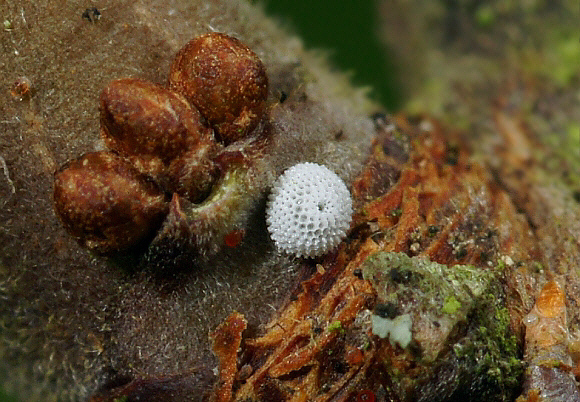 ovum in fork of blackthorn – Adrian Hoskins
ovum in fork of blackthorn – Adrian Hoskins
It’s worth searching almost any blackthorn bush, although the females prefer to lay on young shoots growing in sunny sheltered situations along woodland edges, particularly in the vicinity of ash trees.
One day in September 2009 at Tidworth Ranges I found 28 Brown Hairstreak eggs during a 2 hour search. All were laid on young blackthorn shoots, while older lichen-encrusted growth was ignored by the ovipositing females. The vast majority of eggs were laid on east or south facing woodland edge blackthorns, often 100 metres or more away from the ash trees where the adults meet and copulate. There were definite “hot-spots” favoured by the females, where up to half a dozen eggs could be found close together along a one metre stretch of blackthorn.
The eggs overwinter, and hatch the following April, coinciding with the appearance of the blackthorn buds. The larvae reportedly take up to a whole day to nibble their way out of the egg, after which they rapidly crawl into an unfurling leaf bud where they remain until their first skin moult.
The plump larvae are green with rows of short diagonal whitish dashes along the sides, and very slightly hairy. They live solitarily, feed nocturnally, and rest during the day on the underside of blackthorn leaves, where there cryptic colouration and patterning renders them virtually invisible. Despite the effectiveness of their camouflage however at least 80% of larvae are killed and eaten by predators – spiders, wasps and insectivorous birds.
When fully grown they descend to pupate amongst leaf litter and broken twigs beneath blackthorn bushes. Some authors state that the pupa can also be found attached to the upper surface of leaves or twigs on the bushes. The pupa is dark brown and shiny, with darker freckling on the abdomen. It is reportedly attended by ants Lasius niger which probably offer it a degree of protection against carnivorous beetles. Studies by Jeremy Thomas however concluded that mice and shrews found and consumed a high percentage of pupae, and that at one particular site in Sussex, almost four-fifths of wild pupae were killed by predators.
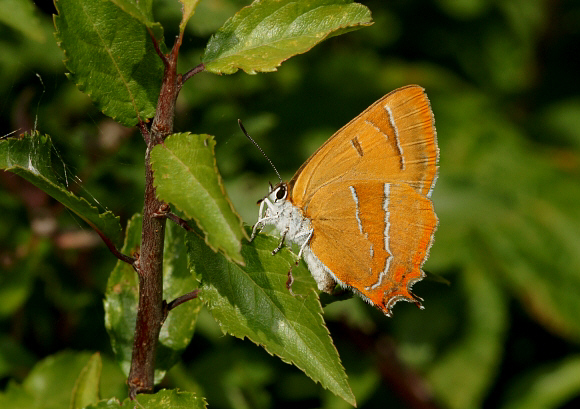 Brown Hairstreak Thecla betulae, female, Steyning, West Sussex – Adrian Hoskins
Brown Hairstreak Thecla betulae, female, Steyning, West Sussex – Adrian Hoskins
Adult behaviour
Brown Hairstreaks begin to emerge at the beginning of August, when recently emerged males can sometimes be seen resting on the terminal leaves of ash saplings. Their first flight takes them to an assembly point – usually at the top of the tallest ash tree in the vicinity. In the absence of ash trees, sycamore, oak and other species are sometimes used.
Males spend most of their lives high up in these so called “master trees”, where they feed on aphid secretions which coat the buds and leaves. They are rarely seen low down, but do occasionally descend to nectar at hemp agrimony or ragwort in years when aphid populations are low, resulting in a scarcity of honey-dew on the ash trees.
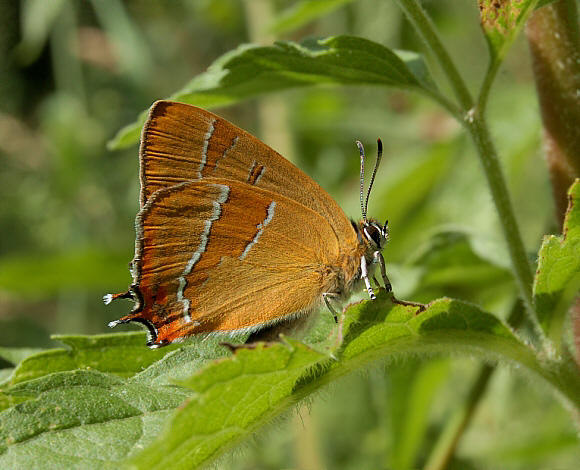
Brown Hairstreak Thecla betulae, female, Noar Hill, Hampshire – Adrian Hoskins
Freshly emerged virgin females can occasionally be found at rest on bushes in the early morning, but as soon as their wings are fully dried and hardened they fly up to join the males in the master trees, of which there are usually several serving each colony. Courtship is very brief and takes place in mid-morning on sunny days. Males have a patch of androconia ( scent scales ) on their upper forewings, from which they disseminate pheromones. As soon as the sexes meet the female responds to this chemical attractant by leading the male to a more sheltered spot lower down on the tree, where copulation takes place immediately. The pair remain joined for about an hour, after which the male returns to the tree tops, where he probably mates with further females.
The females are reputed to remain in the ash trees for about a week while their eggs are maturing, but thereafter spend their lives at lower levels. They are decidedly elusive, but with determination and luck can be discovered crawling about purposefully over young blackthorn twigs, probing with their abdomens to locate suitable places to lay their eggs. On a sunny morning a female will begin ovipositing at about 9.30am, laying perhaps 20 eggs in the course of the next 3 or 4 hours.
Between bouts of egg-laying the butterflies rest for long periods, usually on blackthorn bushes or ash saplings.
Brown Hairstreaks are generally regarded as being sedentary in behaviour, but my observations show that this is certainly not always the case. In late August 2010 for example, I visited Dunch Hill in Wiltshire where I saw 3 females, each on small isolated “islands” of blackthorn scrub, surrounded by broad stretches of grassland. I watched one female basking on blackthorn, and soon afterwards she took flight across an open expanse of grassland, eventually resettling on another blackthorn bush about 150 metres away. These isolated bushes were about 1km distant from the nearest known site – a blackthorn thicket across the county border in Hampshire. Brown Hairstreaks were also reported at the same time from several previously unrecorded sites in Hampshire and Sussex, indicating that in favourable years females will disperse from their traditional habitats, and can turn up at least 2kms away from known sites.
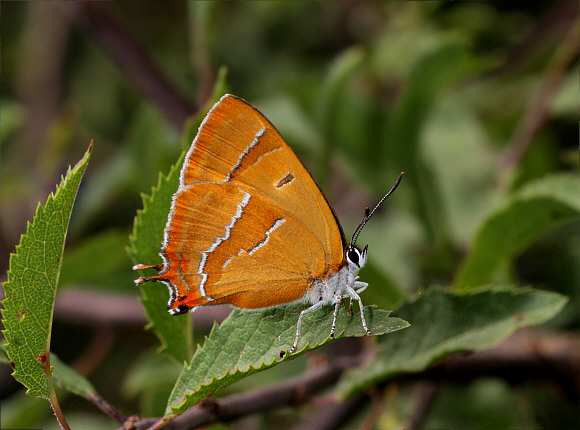
Brown Hairstreak Thecla betulae, female, Tidworth ranges, Hampshire – Adrian Hoskins
Nectaring behaviour varies considerably from site to site – at Selborne for example both sexes are commonly seen at the flowers of hemp agrimony, but at Copsale they nectar almost exclusively at ragwort. Bramble flowers are visited at many sites, and less commonly fleabane or creeping thistle. Once they have settled to feed they often remain at the same clump of flowers for half an hour or more. Both sexes also commonly imbibe the sugary secretions which coat the black buds of ash; and can often be seen probing the surface of ash leaves, feeding on honey dew.
Both sexes feed with their wings tightly closed, but in weak hazy sunlight they can sometimes be found basking on blackthorn bushes or on low foliage, with wings fully outspread.
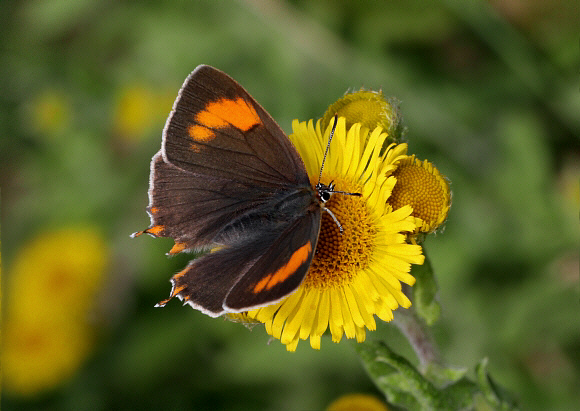 Brown Hairstreak Thecla betulae, female, Alner’s Gorse, Dorset – Adrian Hoskins
Brown Hairstreak Thecla betulae, female, Alner’s Gorse, Dorset – Adrian Hoskins
